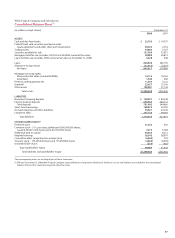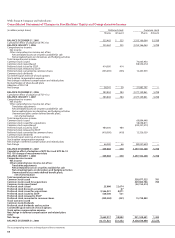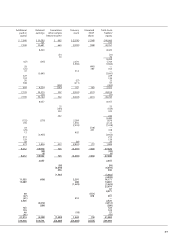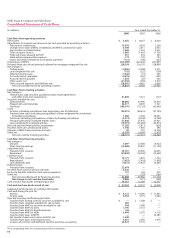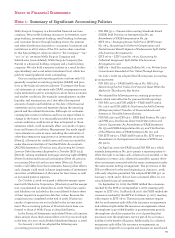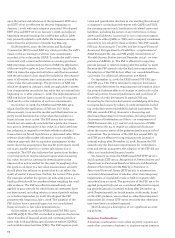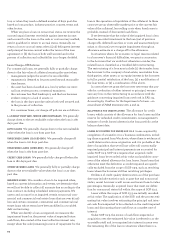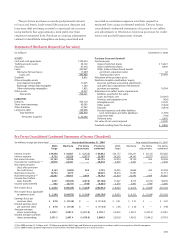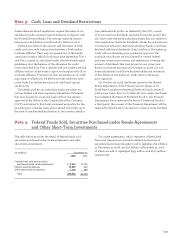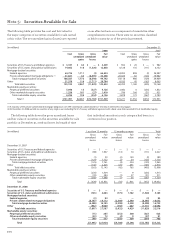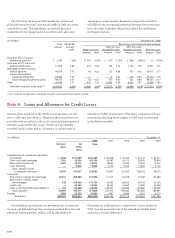Wells Fargo 2008 Annual Report Download - page 98
Download and view the complete annual report
Please find page 98 of the 2008 Wells Fargo annual report below. You can navigate through the pages in the report by either clicking on the pages listed below, or by using the keyword search tool below to find specific information within the annual report.
tors, or when they reach a defined number of days past due
based on loan product, industry practice, country, terms and
other factors.
When we place a loan on nonaccrual status, we reverse the
accrued unpaid interest receivable against interest income
and account for the loan on the cash or cost recovery method,
until it qualifies for return to accrual status. Generally, we
return a loan to accrual status when (a) all delinquent interest
and principal become current under the terms of the loan
agreement or (b) the loan is both well-secured and in the
process of collection and collectibility is no longer doubtful.
Loan Charge-Off Policies
For commercial loans, we generally fully or partially charge
down to the fair value of collateral securing the asset when:
• management judges the asset to be uncollectible;
• repayment is deemed to be protracted beyond reasonable
time frames;
• the asset has been classified as a loss by either our inter-
nal loan review process or external examiners;
• the customer has filed bankruptcy and the loss becomes
evident owing to a lack of assets; or
• the loan is 180 days past due unless both well secured and
in the process of collection.
For consumer loans, our charge-off policies are as follows:
- FAMILY FIRST AND JUNIOR LIEN MORTGAGES We generally
charge down to the net realizable value when the loan is 180
days past due.
AUTO LOANS We generally charge down to the net realizable
value when the loan is 120 days past due.
UNSECURED LOANS (CLOSED END) We generally charge-off
when the loan is 120 days past due.
UNSECURED LOANS (OPEN-END) We generally charge-off
when the loan is 180 days past due.
CREDIT CARD LOANS We generally fully charge-off when the
loan is 180 days past due.
OTHER SECURED LOANS We generally fully or partially charge
down to the net realizable value when the loan is 120 days
past due.
IMPAIRED LOANS We consider a loan to be impaired when,
based on current information and events, we determine that
we will not be able to collect all amounts due according to the
loan contract, including scheduled interest payments. We
assess and account for as impaired certain nonaccrual com-
mercial and commercial real estate loans that are over $5 mil-
lion and certain consumer, commercial and commercial real
estate loans whose terms have been modified in a troubled
debt restructuring.
When we identify a loan as impaired, we measure the
impairment based on the present value of expected future
cash flows, discounted at the loan’s effective interest rate,
except when the sole (remaining) source of repayment for the
loan is the operation or liquidation of the collateral. In these
cases we use an observable market price or the current fair
value of the collateral, less selling costs when foreclosure is
probable, instead of discounted cash flows.
If we determine that the value of the impaired loan is less
than the recorded investment in the loan (net of previous
charge-offs, deferred loan fees or costs and unamortized pre-
mium or discount), we recognize impairment through an
allowance estimate or a charge-off to the allowance.
In situations where, for economic or legal reasons related
to a borrower’s financial difficulties, we grant a concession
to the borrower that we would not otherwise consider, the
related loan is classified as a troubled debt restructuring.
The restructuring of a loan may include (1) the transfer from
the borrower to the company of real estate, receivables from
third parties, other assets, or an equity interest in the borrower
in full or partial satisfaction of the loan, (2) a modification of
the loan terms, or (3) a combination of the above.
In cases where we grant the borrower new terms that pro-
vide for a reduction of either interest or principal, we mea-
sure any loss on the restructuring in accordance with the
guidance concerning impaired loans set forth in FAS 114,
Accounting by Creditors for the Impairment of a Loan – an
amendment of FASB Statements No. 5 and 15.
ALLOWANCE FOR CREDIT LOSSES The allowance for credit
losses, which consists of the allowance for loan losses and the
reserve for unfunded credit commitments, is management’s
estimate of credit losses inherent in the loan portfolio at the
balance sheet date.
LOANS ACCOUNTED FOR UNDER SOP - Loans acquired by
completion of a transfer or in a business combination, includ-
ing those acquired from Wachovia, where there is evidence of
credit deterioration since origination and it is probable at the
date of acquisition that we will not collect all contractually
required principal and interest payments are accounted for
under SOP 03-3. SOP 03-3 requires that acquired credit-
impaired loans be recorded at fair value and prohibits carry-
over of the related allowance for loan losses. Some loans that
otherwise meet the definition as credit impaired are specifi-
cally excluded from the scope of SOP 03-3, such as revolving
loans where the borrower still has revolving privileges.
Evidence of credit quality deterioration as of the purchase
date may include statistics such as past due and nonaccrual
status, recent borrower credit scores and recent loan-to-value
percentages. Generally, acquired loans that meet our defini-
tion for nonaccrual status fall within the scope of SOP 03-3.
Loans within the scope of SOP 03-3 are initially recorded
at fair value. The application of the SOP, and the process esti-
mating fair value involves estimating the principal and inter-
est cash flows expected to be collected on the credit impaired
loans and discounting those cash flows at a market rate of
interest.
Under SOP 03-3, the excess of cash flows expected at
acquisition over the estimated fair value is referred to as the
accretable yield and is recognized into interest income over
the remaining life of the loan in situations where there is a



